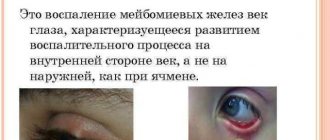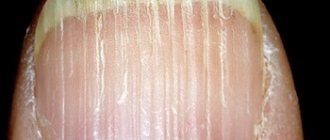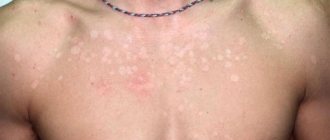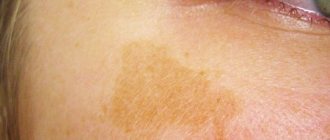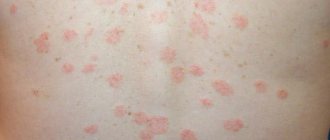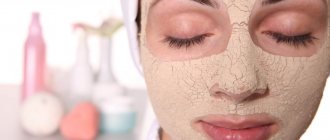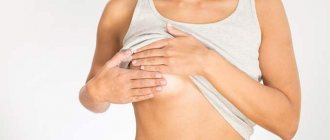Around the nipple are the Montgomery tubercles, glands that moisturize the areola. The appearance of various spots is most often associated with hormonal imbalance or blockage of glands. Redness may indicate the development of an inflammatory process, allergies or dermatitis. Spots on the nipples require detailed attention and examination. The ICD-10 disease code according to the international classification is N60-N64. It is important to understand the causes of the disease and find out whether there is a danger to general health.
Causes of white spots on nipples
Sometimes a woman notices that convex white dots or spots have appeared on the delicate skin of the papilla. A white spot on the nipple can occur for various reasons. The most common pathologies are accompanied by:
- hormonal changes
- dermatological diseases
- gynecological problems
You should not make a diagnosis yourself. A medical examination and consultation with a medical specialist will help identify the causes of the appearance of white spots.
Blocked duct
White dots on the skin may indicate a blockage of the milk duct. This problem sometimes occurs when breastfeeding. It happens that mother's milk accumulates in the gland duct and prevents the rest of the biofluid from leaving. This can happen if the gap between feedings is too long. A white bubble forms on the surface of the nipple. It should not be squeezed out.
The baby can be breastfed after a number of manipulations have been carried out:
- You should gently steam your breasts in warm water.
- Use a soft towel to massage the gland.
- Rub the nipple and lubricate it with sterilized oil.
Only after the above steps are carried out, the baby is applied to the breast. Gently press on the chest. You should also try expressing milk. A breast pump is used for this purpose. If the actions are performed correctly, the problem will be solved.
Thrush
The disease occurs due to the penetration of a fungal infection. Candida fungi affect the nipples and neighboring areas. When the disease occurs, the nipples initially turn pink, after which a white coating forms on their surface. Candidiasis is manifested by unbearable itching, swelling of the areola and nipple, and breast tenderness. Pain may occur during feeding or between feedings. Thrush most often affects the nipples if vaginal candidiasis is present. You need to pay attention if a cheesy white discharge appears from the vagina.
A fungal infection penetrates the nipple through microcracks and pores. Nipple candidiasis often occurs during breastfeeding. A mother can acquire the infection while caring for a baby with diaper rash. For hygienic purposes, a nursing mother should use special pads that should be placed in the bra. The inserts will absorb the secreted milk and will not irritate the nipples. Candidiasis can be caused not only by poor hygiene. Diabetes mellitus, obesity, and anemia can accompany the development of infection. To eliminate the problem, the doctor will recommend the use of antifungal ointment.
Fordyce granules
Fordyce granules may form on the nipples. These growths are not a pathology, but require constant medical supervision. White light formations are small in size. The nodules do not hurt and will not cause discomfort to the woman.
The formations are localized at the border of the areola. Growths occur both on one gland and on two. When pressed, a white thick mass usually releases from the nodule. The cause of the appearance of nodules can be a sebaceous cyst.
Acne
If white spots appear on the nipple, you should check your hormonal levels. Common acne may appear on the nipple and its areola if hormonal changes occur in the body. Wearing a low-quality bra often provokes the appearance of white acne on the nipple. Pimples look unattractive and not aesthetically pleasing, but other than an aesthetic defect they do not pose a threat to health. If pimples on the nipple cause burning and inflammation, measures are taken to eliminate them. Therapy includes the use of anti-inflammatory and hormonal agents.
Acne can occur due to keratinization of the epidermis. The keratinized upper particles of the skin irritate the delicate skin, causing whitish or red pimples.
Blockage of the sebaceous glands
Montgomery's nodes can become clogged. In this case, small white nodules form on the areola. They resemble small pimples. Very often, the glands begin to function intensively during pregnancy. During this period, pigmentation on the nipples and areola may change, or white spots may appear. Small bumps on the nipple can be painful.
When clogged, Montgomery's nodules become similar to teenage acne. When pressed, a brown or greenish secretion may be released from the blisters.
Under no circumstances should you squeeze pimples on the nipple - you can cause an infection.
White spots during pregnancy
Changes in nipple pigmentation occur early on. The mammary glands begin intensive preparation for feeding the baby. The breasts become heavier and fuller, increase in size, and become very sensitive.
During pregnancy, white dots often appear on the nipples. Pigment spots of red, white or dark colors are found on the surface of the nipple. What is the reason for this phenomenon? Nipples become more sensitive during pregnancy. In the mammary glands of a pregnant woman, adipose tissue begins to predominate. Breasts enlarge when carrying a child.
All these changes are caused by increased production of hormones. The condition of the nipples is affected by decreased immunity, concomitant diseases and infections. If the white spots on the nipples do not cause concern and are few in number, then there is no threat to health. After childbirth and breastfeeding, age spots and white spots will disappear. Nipple pigmentation will return to normal.
Depigmentation
The problem of the appearance of white spots around the nipples as a symptom of vitiligo requires separate consideration.
Vitiligo is a disease of autoimmune origin. In such cases, the causes of the disease are unclear. The following actions will help reduce the consequences of the body’s struggle with its own cells:
- Avoiding stress
- Normalization of the gastrointestinal tract and liver
- Regular massage and other relaxing treatments
- Increasing immunity by taking vitamin complexes and immunomodulators
Everyone knows that women's breasts consist of 90% adipose tissue. Each nipple has ducts that can periodically become clogged under the influence of external factors. Blockage can appear in the form of various formations - balls or white dots. These balls are quite dense to the touch; when pressed on them, a white liquid, odorless and viscous in structure, can be released. Mostly women do not feel pain symptoms. But in the bathroom, some women may feel discomfort in their breasts, because during steaming these formations become dense. White dots on the nipples most often appear in nursing mothers and young girls whose mammary glands are actively maturing.
Spots of other colors and causes
The appearance of reddish or brownish spots is associated with mechanical trauma to the nipple. Cracks and redness may occur when breastfeeding a baby. The nipple is irritated by intense motor movements of the baby's mouth and the incorrect position of the baby's gums. Underwear can also cause reddening of the nipple.
Red spots often occur with breast cancer. This is due to damage to the skin and the development of non-plastic pathology. The cancer in this case is eczema-like in nature. Light, black, red or brownish spots appear on the nipple.
Neurodermatitis is another reason for the appearance of spots on the nipple or its areola. The disease is accompanied by burning, pain, and discomfort. Red spots may not have clear boundaries. The inflammatory process can occur due to insufficient breast hygiene during the hot season. Due to the accumulation of sweat, bacteria attack the epidermis and penetrate into the nipple and areola. Inflammation may be accompanied by suppuration.
Tumors
Whiteheads and spots caused by tumors are the most unpleasant and dangerous. In most cases, they are benign in origin, but sometimes such signs are accompanied by cancer.
With cancer of the mammary gland, a woman discovers not only a change in the surface of the nipple, but also a distortion of its shape.
The halo may become covered with growths, peel and itch. If you perform self-diagnosis, you can detect a compaction in the area of skin changes.
What diseases are dangerous?
The spots are a symptom of a developing pathology. Red, brown, and white dots can be caused by:
- herpes
- psoriasis
- fungus
- impetigo
- inflammation
- dermatitis
- cancer
As the inflammatory process develops, the uneven vesicle is filled with yellow serous fluid. The spot may hurt. Neurodermatitis is associated with neuroendocrine disorders. The pathogenesis of redness is caused by changes in the functions of the central nervous system and impaired functioning of the endocrine glands. Certain reactions begin in the body. The result is redness of the areola and nipple. Symptoms of the pathology are hyperemia of the skin, unstable emotions of the patient, and a burning sensation in the chest.
The inflammatory process in the nipples is often associated with a lack of necessary anti-inflammatory substances in the body. Cortisone deficiency sometimes causes the nipples to become sore and red. The pathology is associated with the penetration of staphylococci into the nipple. The disease is caused by microtraumas of the nipple and the accumulation of biofluid.
The psoriatic process develops due to decreased immunity and endocrine disorders. The spots can also be of viral etiology. It is important to correctly determine the root cause of spots on the nipple. The appearance of the spot is accompanied by signs - the nipple may itch and peel.
Impetigo is a disease that affects the nipples and areola. The disease develops due to infection. Pus accumulates in the vesicle, and the pink spot on top becomes covered with a crust. Such conflicts merge into a single speck.
Fordyce granules
They are small whitish or yellowish spots that appear on the nipples, face, chest, lips or genitals. Another name for these granules is seborrheic cysts; they are not a disease, but appear due to the peculiarities of the subcutaneous glands. As a rule, this small defect most often bothers people in adolescence, during the period of increased activity of the sebaceous glands.
White spots on the nipple may be indicators of Fordyce granules. This disease is not life-threatening, but is an unpleasant, clearly visible cosmetic defect.
Treatment
- concerns about burning, itching in the area of white spots;
- the rash worsens during menstrual periods;
- the disease has lasted for more than ten years;
- spots in the form of nodules (regardless of gender).
Another reason why a white, painful dot appears on the nipple may be a simple aesthetic defect. A small white speck, which is an individual feature of the structure of the sebaceous glands, means a blockage of the sebaceous canal. This defect is called “Fordyce granules”.
White nodules do not cause discomfort until, due to hormonal imbalance, they begin to become engorged with blood, become inflamed and cause discomfort in the form of itching and pain. These symptoms usually appear during menstruation. In this case, we are talking about Fox–Fordyce disease, which requires symptomatic treatment.
Similar to those that occur on the nipples, Fordyce granules can be seen in the armpits, pubic area, and genitals. The disease occurs in relapses, but after the age of forty it declines and disappears completely.
What to do
The problem should be dealt with by a qualified doctor. Taking antibiotics helps stop inflammation. Additional immunostimulants and sedatives are prescribed. In some cases, it is recommended to steam and massage the breasts. Hormonal correction also helps get rid of spots. Treatment with drugs is carried out under the supervision of physicians.
If stains and irritation are due to improperly fitted underwear, you should change your bra. The product is selected according to its size. The bra should support the bust and not tighten it.
It is important to remember that redness may be due to heat rash. The glands should be washed with warm water daily. Taking a shower will help wash away accumulated sweat and prevent the proliferation of bacterial flora. Water procedures must be carried out without the use of soap, which can irritate the delicate nipple and cause allergies. You need to take care of your mammary glands every day.
Conclusion
If you see white spots on the surface of your chest, you should not self-medicate. You should immediately seek help from a medical specialist who will determine the cause of their occurrence and prescribe effective treatment.
White spots on the mammary papillae appear for various reasons, so only a qualified specialist can determine the provoking factor.
Let us analyze the features of this clinical condition, whether it is dangerous to health, and what therapeutic measures help to recover from the anomaly.
Treatment methods
If the obstruction of the milk duct does not provoke inflammation, treatment as such is not required.
But what to do if the milk ducts are regularly clogged? In this case, you can get rid of milk that has stagnated in the breast only with the help of a doctor.
The specialist will first of all help the woman establish her relationship. The cause of relapse often lies in improper breastfeeding.
Ultrasonic exposure can help get rid of a blocked duct. The rays are directed directly to the affected area for 5 minutes 2 times a day.
Treatment with this method is carried out in cases where it was not possible to get rid of stagnation in the duct within 48 hours.
In order to enhance the effect of the procedure, the woman is additionally prescribed lecithin. It not only helps to increase the flow of milk, but also expands the ducts.
In some cases, obstruction of the milk ducts is treated with medications. For this purpose, the following groups of drugs are used:
- hormonal drugs;
- estrogens, and they are prescribed both separately and together with dopamine receptor agonists;
- if blocking the hormone prolactin is required, the woman is prescribed stimulant inhibitors.
But remember, any treatment should be prescribed only by the attending physician. Self-medication can provoke such a serious complication as mastitis.
You can get rid of stagnation of the milk ducts by using traditional medicine methods. But this applies only to the initial stage of the disease.
In all other cases, treatment is carried out by a doctor. Here are some effective recipes:
- The most popular method to help get rid of obstruction of the milk ducts is. After kneading it a little, it is applied to the affected area and left overnight.
- Honey and apple compresses. Both products have the ability to cause blood to flow to the breasts, which helps dilate the ducts. The honey is preheated a little, and the apple is grated on a fine grater.
- Warming flatbread. To prepare it, you need to take equal amounts of honey, flour and butter. Mix all ingredients and form into a flat cake. It should be applied to the breast constantly, taking a break only while feeding the baby.
- You can relieve swelling or inflammation by applying ice or cold cottage cheese to your breasts.
- Baked onion compress. To do this, it is cut into two halves, baked, allowed to cool and applied to the affected area for several hours.
If milk stagnation cannot be eliminated at home within 24 hours, you should consult a doctor.
In addition, if there are signs of inflammation, such as fever, severe pain or redness of the skin, the use of traditional methods is strictly prohibited. Remember, in case of mastitis, any warm compresses can only do harm.
Mammologist's advice for lactostasis
When the blockage of the milk duct occurs far from the exit, simply developing the nipple during feeding and systematically massaging the tip of the breast may not be enough: in this way, the woman releases the exit itself without removing tension from the busy duct. In this case, a radical, critical pumping is necessary, which can be painful.
It is better to express over a sink, since the moment the canal is freed from the blockage, the milk will hit in a strong stream. Using finger movements from the base of the nipple to the outlet, you need to simultaneously flatten and push the breast until the bubble opens and the plug comes out. The pain will immediately decrease after this. If after two such procedures the clot does not come out, an examination and consultation with a mammologist is mandatory, and the sooner the better.
Fat necrosis in the mammary gland
The problem occurs in nursing mothers; the blockage is characterized by the appearance of a white bubble and the appearance of a hard-to-touch lobule in one of the mammary glands. If the hardening does not go away even after feeding, then appropriate measures should be taken. Such white pimples on the papillae in women indicate that milk has accumulated in the ducts and cannot find a way out. Inaction in such cases can lead to a further increase in temperature and the occurrence of mastitis.
Causes
- For a mother breastfeeding her baby:
- in the absence of regular feeding;
- Hind milk, which is richer in fat, can clog the duct;
- the baby spends little time at the mother’s breast;
- if the mother feeds the baby in the same position;
- incorrect grip of the nipple by the baby;
- uncomfortable position of the child during feeding when the duct is clamped;
- sleep in a prone position.
- If a woman finishing breastfeeding deliberately squeezes her breasts with a tight bandage or uncomfortable clothing.
Prevention
During breastfeeding, you should adhere to certain rules that will help keep your mammary glands healthy.
- When feeding your baby, change your position and his position more often;
- Try to feed your baby on demand (as much as he wants);
- Do not take long breaks between night feedings;
- Make sure that the baby makes a correct, comprehensive and deep nipple latch;
- Avoid chest injury or compression;
- Sleep mainly on your back, on your side;
- Inspect your breasts more often and feel them daily: there should be no white or red spots on the nipples or others;
- Allow yourself to rest; breast milk is produced by a healthy, calm mother.
Depending on the nature of the lump (seal, lump, node), the following palpable formations can be distinguished:
- lipoma;
- fat necrosis;
- cyst;
- adenoma;
- lactostasis;
- calcification;
- thrombosis.
It must be said that not each of these formations is necessarily detected during self-examination. If a lump or lump is less than 10 mm in diameter and is located on the periphery of the breast, it is difficult to detect it on your own. In such situations, tumor-like clusters are discovered by chance during other studies.
The death of adipose tissue cells often leads to their rotting and the formation of abscesses. To the touch, fat necrosis is a soft, mobile compaction, often inextricably linked to the skin. If the area around the nipple is affected, it may become inverted.
There is no treatment for fat necrosis; only removal is recommended, since the development pattern is very similar to a malignant process.
When studying the mammary glands, a number of compactions of various types formed in the glandular, stroma tissues or ducts were called mastopathy. Mastopathy is characterized by compactions of different shape, pain, structure, however, in 95% of cases they are benign.
Lumps of different nature and density are combined under the term “mastopathy” due to their hormone dependence. A connection has been established with a high degree of certainty between mastopathy and the predominance of estrogen over progesterone, excessive production of prolactin and secretion of the thyroid gland.
Fibrous formations feel loose to the touch, but are often identified as compactions. They consist of connective tissue in which atypical cell division processes occur. Often fibrous compactions are noticeable before menstruation and in its first days, spontaneously disappear on days 5-6. If treatment is required, emphasis is placed on antihormonal therapy.
Adenoma, fibroadenoma is a lump that hurts when palpated. Its contours are clear and smooth, of regular shape. Such formations, unlike cysts and fibrosis, are tumors, so a biopsy is often prescribed for an accurate diagnosis. Such seals are of increased interest in diagnosis; often, if they are large, the doctor insists on removal. It is adenomas that are prone to malignancy. Small, scattered adenomas are observed and conservative treatment is used.
Hormonal imbalances
White spots on the chest may be a symptom of hormonal imbalance.
Very often such hormonal imbalances occur:
- in adolescents during puberty;
- in older people;
- women during menopause or menstruation.
White nipples in such categories of people indicate a hormonal imbalance in the body. In addition to constant monitoring of personal hygiene and a strict diet, it is recommended to consult a specialist who will draw up a treatment plan and prescribe the necessary medications to normalize hormonal levels.
